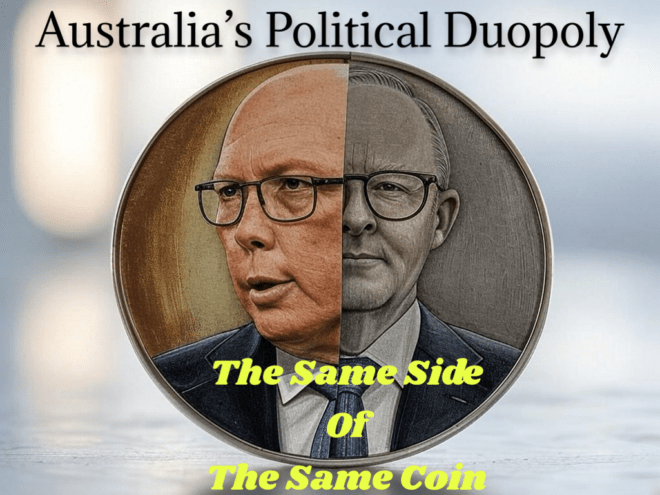
Abstract
This paper examines the political landscape of Australia, characterised by a duopoly primarily dominated by the Liberal and Labor parties. It argues that this system, heavily influenced by career politicians, lobbyists, and corporate donors, has undermined the democratic process in Australia. However, it also considers counterarguments that suggest the stability provided by this duopoly can lead to effective governance. Through a comprehensive analysis of the role of political parties, the influence of lobbying, and the implications of corporate donations, this paper aims to provide a balanced perspective on the state of democracy in Australia.
Introduction
The Australian political system has been shaped significantly by the dominance of two major parties: the Australian Labor Party (ALP) and the Liberal Party of Australia. This duopoly has not only influenced policy decisions but has also limited the political discourse to a narrow spectrum of ideologies. The origins of this political structure can be traced back to the early 20th century, a period marked by social change and the emergence of distinct political ideologies. This paper will explore the historical context surrounding the establishment of the ALP and the Liberal Party, analyze their evolution over the decades, and discuss the implications of their dominance on the broader political landscape, particularly concerning alternative parties.
Historical Context
The Formation of the Australian Labor Party
The Australian Labor Party was founded in 1891, emerging from the labor movement that sought to represent the interests of workers and address issues such as workers’ rights, social justice, and economic equity. The party’s formation can be seen as a response to the industrialisation and urbanisation of Australia, which led to the rise of a working-class identity. The ALP’s platform was rooted in the principles of socialism and trade unionism, aiming to empower workers and provide them with a political voice.
The ALP’s early successes were evident in the 1901 federal election, where it secured a significant number of seats, signaling the growing political consciousness among the working class. The party’s establishment marked a critical shift in Australian politics, as it introduced a new ideological perspective that challenged the existing conservative order.
The Emergence of the Liberal Party
In contrast, the Liberal Party was established in 1945, evolving from the United Australia Party (UAP) and other conservative factions. The formation of the Liberal Party was a strategic response to the changing political landscape and the need for a unified conservative voice. The party aimed to represent business interests, promote free-market policies, and uphold traditional social values.
The Liberal Party’s rise to prominence can be attributed to its ability to attract a broad coalition of voters, including those disenchanted with the ALP’s policies. The party’s leadership under figures such as Robert Menzies played a crucial role in shaping its identity and electoral success. Menzies’ government, which lasted from 1949 to 1966, solidified the Liberal Party’s position as a major political force in Australia.
Characterisation of the Australian political duopoly
Limited Political Diversity: The dominance of the Liberal and Labor parties often marginalises smaller parties and independent candidates, leading to a lack of diverse political representation.
Career Politicians: Many politicians within these parties have long careers in politics, which can lead to a disconnect from the electorate and a focus on party loyalty over constituent needs.
Influence of Lobbyists and Corporate Donations: The reliance on funding from corporate donors and lobbyists raises questions about the integrity of the political process and the extent to which elected officials prioritise public interest over private gain.
The Evolution of the Duopoly
Over the decades, the ALP and the Liberal Party have dominated both federal and state elections, often alternating in power. This duopoly has created a political environment where alternative parties, such as the Greens or various independent movements, struggle to gain a foothold. The two-party system has been reinforced by several factors, including the preferential voting system, which tends to favor established parties, and the media’s focus on the major parties during elections.
The stability provided by the duopoly has led to a perception of predictability in Australian politics, with voters often feeling compelled to choose between the two major parties, even when they may not fully align with their ideologies. This phenomenon is often referred to as the “lesser of two evils” syndrome, where voters prioritize the defeat of one party over their support for the other.
Challenges Faced by Alternative Parties
The dominance of the ALP and the Liberal Party has created significant barriers for alternative parties. The electoral system, characterised by single-member districts and preferential voting, makes it challenging for smaller parties to win seats. Additionally, the media landscape tends to favor the major parties, providing them with more visibility and resources for campaigning.
While there have been instances of success for alternative parties, such as the Greens’ rise in the 21st century, these successes have often been limited to specific regions or issues rather than translating into widespread political influence. The political culture in Australia has thus been shaped by the entrenched interests of the two major parties, leading to a lack of diversity in political representation.
Characteristics of the Duopoly
The Argument Against the Duopoly
Erosion of Democratic Principles
Critics of the political duopoly argue that it undermines the democratic principles of representation and accountability. The following points highlight the detrimental effects of this system:
Lack of Choice for Voters: With limited options at the ballot box, voters may feel compelled to vote for the lesser of two evils rather than a candidate who truly represents their views. This can lead to voter apathy and disengagement from the political process.
Policy Capture by Special Interests: The influence of lobbyists and corporate donors can result in policy decisions that favor a select few over the broader public interest. For instance, industries such as mining and pharmaceuticals have been known to exert significant influence on government policy, often at the expense of environmental sustainability and public health.
Accountability Issues: Career politicians may prioritise party loyalty over accountability to their constituents. This can result in decisions that do not reflect the will of the people, further eroding trust in democratic institutions.
Case Studies
The Adani Coal Mine Controversy
The proposed Adani coal mine in Queensland has become a flashpoint in the debate over environmental sustainability versus economic development. Proponents argue that the project will generate jobs, stimulate the economy, and enhance Australia’s energy security. The Queensland Government, along with the Federal Government, has supported the project, emphasising its economic benefits.
Arguments Supporting the Project
Supporters of the Adani coal mine argue that it represents a significant economic opportunity for regional communities. According to the Queensland Government, the project is expected to create thousands of jobs and contribute to the local and national economy. Proponents also highlight the importance of coal in Australia’s energy mix, suggesting that it is essential for energy security, especially as the country transitions to renewable sources.
Environmental Concerns and Public Opposition
Conversely, the project has faced intense public opposition from environmentalists, Indigenous groups, and a significant portion of the electorate. Critics argue that the mine poses severe risks to the Great Barrier Reef, contributes to climate change, and undermines Australia’s commitments to reducing carbon emissions. Notably, a report by the Australian Conservation Foundation highlighted the potential for irreversible damage to local ecosystems. The public outcry illustrates a growing demand for greater environmental accountability from policymakers.
Corporate Lobbying and Political Influence
The approval process for the Adani mine raised serious concerns about the influence of corporate lobbying on political decision-making. Investigations revealed that significant financial contributions from mining interests to political parties may have swayed decisions in favor of the project. This situation underscores the potential for corporate interests to overshadow public sentiment and environmental considerations, raising ethical questions about the integrity of the democratic process.
Health Policy and Pharmaceutical Lobbying
The relationship between the Australian government and pharmaceutical companies exemplifies the complexities of health policy influenced by corporate lobbying. Critics argue that lobbying efforts have compromised the integrity of health policies, favouring corporate profits over public health.
The Role of Pharmaceutical Companies
Pharmaceutical companies play a crucial role in the Australian healthcare system, providing essential medications and innovations. However, their lobbying efforts have drawn scrutiny, particularly regarding drug pricing and access to medications. The Pharmaceutical Benefits Scheme (PBS) is designed to ensure that essential medications are affordable for Australians, but critics argue that the influence of pharmaceutical companies has led to inflated drug prices and restricted access.
Impact on Public Health Policy
Research indicates that lobbying by pharmaceutical companies has resulted in policies that prioritise profit margins over patient needs. A study by the Australian Institute of Health and Welfare highlighted discrepancies in drug pricing, with some essential medications remaining unaffordable for many Australians. This situation raises critical questions about the efficacy of health policies and the degree to which they serve the public interest.
Ethical Implications of Lobbying
The ethical implications of pharmaceutical lobbying extend beyond pricing. The potential for conflicts of interest in policymaking processes can undermine public trust in health institutions. Critics argue that the revolving door between government and industry exacerbates these issues, as former politicians and bureaucrats often take lucrative positions within pharmaceutical companies, further blurring the lines between public service and corporate interests.
Counterarguments: The Case for the Duopoly
While the criticisms of Australia’s political duopoly are compelling, it is essential to consider the arguments in favour of the existing system:
Stability and Governance
Proponents argue that the duopoly provides stability, which is crucial for effective governance. The following points support this view:
- Clear Policy Direction: A two-party system can lead to more coherent and consistent policy frameworks, reducing the risk of gridlock that can occur in multi-party systems.
- Accountability Mechanisms: The presence of two dominant parties creates a competitive environment where each party is incentivised to perform well to win elections. This can enhance accountability as parties seek to appeal to a broad electorate.
- Historical Success: Australia’s political stability and economic growth over the past few decades are often attributed to the effectiveness of its two-party system. Proponents argue that the duopoly has facilitated sound economic management and social policies.
Evidence of Democratic Functioning
Despite the criticisms, evidence suggests that Australia’s democracy functions effectively in many respects:
- High Voter Turnout: Australia consistently reports high voter turnout rates, indicating a level of public engagement and investment in the democratic process.
- Independent Electoral Commission: The Australian Electoral Commission operates independently to oversee fair elections, contributing to the integrity of the electoral process.
- Active Civil Society: A vibrant civil society, including advocacy groups and grassroots movements, continues to challenge the status quo and push for reforms, demonstrating that democracy is alive and active.
Conclusion
The debate surrounding Australia’s political duopoly is complex, encompassing valid concerns about the erosion of democratic principles alongside arguments for the stability and effectiveness of the system. While the influence of career politicians, lobbyists, and corporate donors raises significant challenges, the duopoly also provides a framework for governance that has delivered stability and economic growth. Moving forward, it is crucial for Australia to address the concerns regarding representation and accountability while recognising the strengths of its political system. Ultimately, fostering a more inclusive democracy may require reforms that enhance transparency, reduce the influence of money in politics, and encourage diverse political participation.


